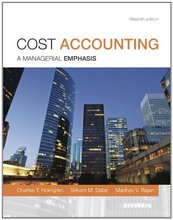Cost Accounting Horngren 15th Edition Test Bank
$35.00
Cost Accounting Horngren 15th Edition Test Bank
Cost Accounting
Cost Accounting Horngren Datar Rajan
Cost Accounting Horngren Datar Rajan 15th
Cost Accounting Horngren Datar Rajan 15th Test Bank
Cost Accounting Horngren 15th Edition Test Bank
*** YOU ARE BUYING the Test Bank ***
Name: Cost Accounting
Author: Horngren Datar Rajan
Edition: 15th
ISBN-10: 0133428702
ISBN-13: 978-0133428704
Type: Test Bank
– there’s a very high chance that you will see a very similar, if not exact the exact, question in the test!
–
–
If you have any questions, please feel free to contact us. Our response is the fastest. All questions will always be answered in 6 hours., most of the time within 30mins
We also faced similar difficulities when we were students, and we understand how you feel.
But now, with the Cost Accounting 15th Test Bank, you will be able to
* Anticipate the type of the questions that will appear in your exam.
* Reduces the hassle and stress of your student life.
* Improve your studying and also get a better grade!
* Get prepared for examination questions.
* Can save you time and help you understand the material.
This is the quality of service we are providing and we hope to be your helper.
Test Bank is accurate.
Prepare to receive your Cost Accounting 15th Test Bank in the next moment.
ISBN-10: 0133428702
ISBN-13: 978-0133428704
If you have any questions, or would like a receive a sample chapter before your purchase, please contact us at [email protected]
Cost Accounting
Cost Accounting Horngren Datar Rajan
Cost Accounting Horngren Datar Rajan 15th
Cost Accounting Horngren Datar Rajan 15th Test Bank
Cost Accounting Horngren 15th Edition Test Bank
Cost Accounting, 15e (Horngren/Datar/Rajan)
Chapter 1 The Manager and Management Accounting
Objective 1.1
1) Management accounting ________.
A) focuses on estimating future revenues, costs, and other measures to forecast activities and their results
B) provides information about the company as a whole
C) reports information that has occurred in the past that is verifiable and reliable
D) provides information that is generally available only on a quarterly or annual basis
Answer: A
Diff: 1
Objective: 1
AACSB: Analytical thinking
2) Managers use management accounting information to ________.
A) help external users such as investors, banks, regulators, and suppliers
B) communicate, develop, and implement strategies
C) communicate a firm’s financial position to investors, banks, regulators, and other outside parties
D) ensure that financial statements are consistent with the SEC rules
Answer: B
Diff: 1
Objective: 1
AACSB: Analytical thinking
3) Financial accounting ________.
A) focuses on the future and includes activities such as preparing next year’s operating budget
B) must comply with GAAP (generally accepted accounting principles)
C) is the process of measuring, analyzing, and reporting financial and nonfinancial information related to the costs of acquiring or using resources in an organization
D) is prepared for the use of department heads and other employees
Answer: B
Diff: 1
Objective: 1
AACSB: Analytical thinking
4) The primary user of financial accounting information is a ________.
A) factory shift supervisor
B) distribution manager
C) current shareholder
D) department manager
Answer: C
Diff: 1
Objective: 1
AACSB: Analytical thinking
5) The primary user of management accounting information is a(n) ________.
A) the controller
B) a shareholder evaluating a stock investment
C) bondholder
D) external regulator
Answer: A
Diff: 1
Objective: 1
AACSB: Analytical thinking
6) Financial accounting provides the primary source of information for ________.
A) decision making in the finishing department
B) improving customer service
C) preparing the income statement for shareholders
D) planning next year’s operating budget
Answer: C
Diff: 1
Objective: 1
AACSB: Analytical thinking
7) Which of the following is true of management accounting information?
A) It focuses on documenting past business actions of a firm.
B) It is prepared based on SEC rules and FASB accounting principles.
C) It is prepared for shareholders.
D) It co-ordinates product design, production, and marketing decisions.
Answer: D
Diff: 2
Objective: 1
AACSB: Analytical thinking
8) Which of the following statements refers to management accounting information?
A) There are no regulations governing the reports.
B) The reports are generally delayed and historical.
C) The audience tends to be stockholders, creditors, and tax authorities.
D) It primarily measures manager’s compensation on reported financial results.
Answer: A
Diff: 2
Objective: 1
AACSB: Analytical thinking
9) Which of the following groups would be least likely to receive detailed management accounting reports?
A) stockholders
B) sales managers
C) production supervisors
D) distribution managers
Answer: A
Diff: 1
Objective: 1
AACSB: Analytical thinking
10) Management accounting information typically includes ________.
A) tabulated results of customer satisfaction surveys
B) the cost of producing a product
C) the percentage of units produced that are defective
D) All of these answers are correct.
Answer: D
Diff: 1
Objective: 1
AACSB: Application of knowledge
11) Cost accounting ________.
A) measures the costs of acquiring or using resources in an organization
B) helps managers to develop, communicate, and implement strategies
C) coordinates product design, production, and marketing decisions and evaluate a company’s performance
D) communicates information to investors, banks, regulators, and other outside parties
Answer: A
Diff: 1
Objective: 1
AACSB: Analytical thinking
12) Which of the following differentiates cost accounting and financial accounting?
A) The primary users of cost accounting are the investors, whereas the primary users of financial accounting are the managers.
B) Cost accounting deals with product design, production, and marketing strategies, whereas financial accounting deals mainly with pricing of the products.
C) Cost accounting measures only the financial information related to the costs of acquiring fixed assets in an organization, whereas financial accounting measures financial and nonfinancial information of a company’s business transactions.
D) Cost accounting measures information related to the costs of acquiring or using resources in an organization, whereas financial accounting measures a financial position of a company to investors, banks, and external parties.
Answer: D
Diff: 2
Objective: 1
AACSB: Analytical thinking
13) Which of the following is true of financial accounting information?
A) It is prepared based on cost-benefit analysis.
B) It is primarily used by managers to make internal business decisions.
C) It focuses on the past-oriented financial performance of a company.
D) It only measures the cash transactions of a company.
Answer: C
Diff: 2
Objective: 1
AACSB: Analytical thinking
14) A data warehouse or infobarn ________.
A) is reserved for exclusive use by the CFO
B) is primarily used for financial reporting purposes
C) stores information used by different managers for multiple purposes
D) gathers only nonfinancial information
Answer: C
Diff: 1
Objective: 1
AACSB: Analytical thinking
15) Which of the following is true of cost accounting?
A) It provides financial information about cash-based transactions only.
B) It accounts only the financial information of business transactions, not the nonfinancial information.
C) It provides financial information regarding the cost of acquiring resources.
D) It must be prepared in accordance with GAAP.
Answer: C
Diff: 2
Objective: 1
AACSB: Analytical thinking
16) Which of the following deals with management accounting?
A) identifying the costs of acquiring the resources of the company
B) developing budgets
C) preparing the income statement
D) preparing the statement of cash flows
Answer: B
Diff: 1
Objective: 1
AACSB: Analytical thinking
17) Financial accounting is concerned primarily with ________.
A) external reporting to investors, creditors, and government authorities
B) cost planning and cost controls
C) product design and marketing strategies
D) providing information for strategic and tactical decisions
Answer: A
Diff: 1
Objective: 1
AACSB: Analytical thinking
18) Financial accounting provides a historical perspective, whereas management accounting emphasizes ________.
A) the future
B) past transactions
C) a current perspective
D) reports to shareholders
Answer: A
Diff: 1
Objective: 1
AACSB: Analytical thinking
19) An Enterprise Resource Planning System can best be described as ________.
A) a collection of programs that use a variety of unconnected databases
B) a single database that collects data and feeds it into applications that support each of the company’s business activities, such as purchases, production, distribution, and sales
C) a database that is primarily used by a purchasing department to determine the correct amount of a particular supply item to purchase
D) a sophisticated means of linking two or more companies to facilitate their planning processes
Answer: B
Diff: 2
Objective: 1
AACSB: Analytical thinking
20) The approaches and activities of managers in short-run and long-run planning and control decisions that increase value for customers and lower costs of products and services are known as ________.
A) value chain management
B) enterprise resource planning
C) cost management
D) customer value management
Answer: C
Diff: 1
Objective: 1
AACSB: Analytical thinking
21) Financial accounting information focuses on internal reporting.
Answer: FALSE
Explanation: Management accounting information focuses on internal reporting and financial accounting focuses on external reporting.
Diff: 1
Objective: 1
AACSB: Analytical thinking
22) Cost accounting provides information for both management accounting and financial accounting professionals.
Answer: FALSE
Explanation: Cost accounting provides information for both management accounting and financial accounting professionals.
Diff: 2
Objective: 1
AACSB: Analytical thinking
23) Management accounting information and reports do not have to follow set principles or rules such as GAAP.
Answer: TRUE
Diff: 1
Objective: 1
AACSB: Analytical thinking
24) Management accounting ensures communication of an organization’s financial position to investors, banks, and regulators.
Answer: FALSE
Explanation: Financial accounting, not management accounting, ensures communication of an organization’s financial position to investors, banks, and regulators.
Diff: 1
Objective: 1
AACSB: Analytical thinking
25) The balance sheet, income statement, and statement of cash flows are used for financial accounting, and also for management accounting.
Answer: TRUE
Diff: 1
Objective: 1
AACSB: Analytical thinking
26) Financial accounting is broader in scope than management accounting.
Answer: FALSE
Explanation: Management accounting is broader in scope than financial accounting.
Diff: 1
Objective: 1
AACSB: Analytical thinking
27) Cost accounting measures and reports short-term, long-term, financial, and non financial information.
Answer: TRUE
Diff: 2
Objective: 1
AACSB: Analytical thinking
28) Cost accounting is the process of measuring, analyzing, and reporting financial and nonfinancial information related to the costs of acquiring or using resources in an organization.
Answer: TRUE
Diff: 1
Objective: 1
AACSB: Analytical thinking
29) Management accounting has to strictly follow the rules of generally accepted accounting principles for the purposes of measurement and reporting.
Answer: FALSE
Explanation: Internal measures and reports do not have to follow GAAP.
Diff: 2
Objective: 1
AACSB: Analytical thinking
30) For management accounting, internal measurement and reporting are based on cost-benefit analysis.
Answer: TRUE
Diff: 2
Objective: 1
AACSB: Analytical thinking
31) An Enterprise Resource Planning (ERP) System is a single database that collects data and feeds into applications that support each of the company’s business activities, such as purchases, production, distribution, and sales.
Answer: TRUE
Diff: 1
Objective: 1
AACSB: Analytical thinking
32) Financial accounting provides an organization’s past-oriented information such as the previous years’ financial statements.
Answer: TRUE
Explanation: Financial accounting provides an organization’s past-oriented information such as the previous years’ financial statements.
Diff: 1
Objective: 1
AACSB: Analytical thinking
33) Cost management not only helps reducing costs but also improving customer satisfaction and the quality of a firm’s products.
Answer: TRUE
Diff: 1
Objective: 1
AACSB: Analytical thinking












Reviews
There are no reviews yet.